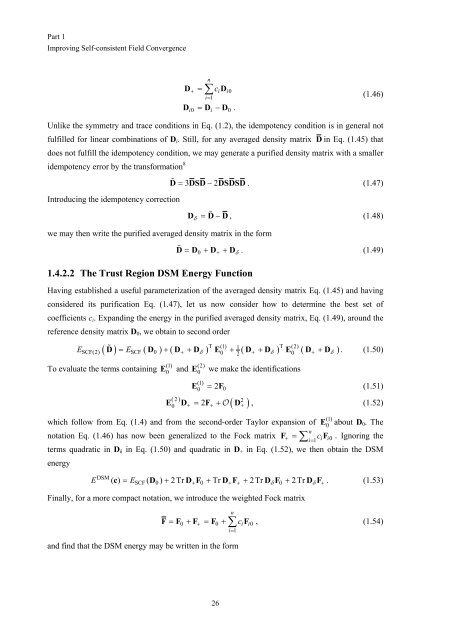Get my PhD Thesis
Get my PhD Thesis
Get my PhD Thesis
Create successful ePaper yourself
Turn your PDF publications into a flip-book with our unique Google optimized e-Paper software.
Part 1<br />
Improving Self-consistent Field Convergence<br />
D<br />
+<br />
=<br />
n<br />
∑<br />
i=<br />
1<br />
c D<br />
i0<br />
D = D −D<br />
i0 i 0 .<br />
i<br />
(1.46)<br />
Unlike the symmetry and trace conditions in Eq. (1.2), the idempotency condition is in general not<br />
fulfilled for linear combinations of D i . Still, for any averaged density matrix D in Eq. (1.45) that<br />
does not fulfill the idempotency condition, we may generate a purified density matrix with a smaller<br />
idempotency error by the transformation 8<br />
D = 3DSD−2DSDSD. (1.47)<br />
Introducing the idempotency correction<br />
Dδ = D − D, (1.48)<br />
we may then write the purified averaged density matrix in the form<br />
D = D + D + D . (1.49)<br />
0 + δ<br />
1.4.2.2 The Trust Region DSM Energy Function<br />
Having established a useful parameterization of the averaged density matrix Eq. (1.45) and having<br />
considered its purification Eq. (1.47), let us now consider how to determine the best set of<br />
coefficients c i . Expanding the energy in the purified averaged density matrix, Eq. (1.49), around the<br />
reference density matrix D 0 , we obtain to second order<br />
T<br />
( ) ( ) ( ) (1) 1<br />
T<br />
D = D + D+ + D E + ( D+ + D ) E (2) ( D+<br />
+ D )<br />
E E δ δ δ . (1.50)<br />
SCF(2) SCF 0 0 2<br />
0<br />
To evaluate the terms containing<br />
(1)<br />
E<br />
0<br />
and<br />
(2)<br />
E<br />
0<br />
we make the identifications<br />
(1)<br />
0<br />
= 2 0<br />
2 2<br />
0 + = 2 + + +<br />
E F (1.51)<br />
( )<br />
( )<br />
E D F O D , (1.52)<br />
which follow from Eq. (1.4) and from the second-order Taylor expansion of about D 0 . The<br />
n<br />
notation Eq. (1.46) has now been generalized to the Fock matrix F+ = ∑ c<br />
i=<br />
1 iF i0<br />
. Ignoring the<br />
terms quadratic in D δ in Eq. (1.50) and quadratic in D + in Eq. (1.52), we then obtain the DSM<br />
energy<br />
DSM<br />
E () = ESCF ( 0 ) + 2Tr + 0 + Tr + + + 2Tr δ 0 + 2Tr δ +<br />
(1)<br />
E0<br />
c D DF DF DF DF. (1.53)<br />
Finally, for a more compact notation, we introduce the weighted Fock matrix<br />
n<br />
0 + 0 ci<br />
i0<br />
i=<br />
1<br />
and find that the DSM energy may be written in the form<br />
F = F + F = F +∑ F , (1.54)<br />
26

















